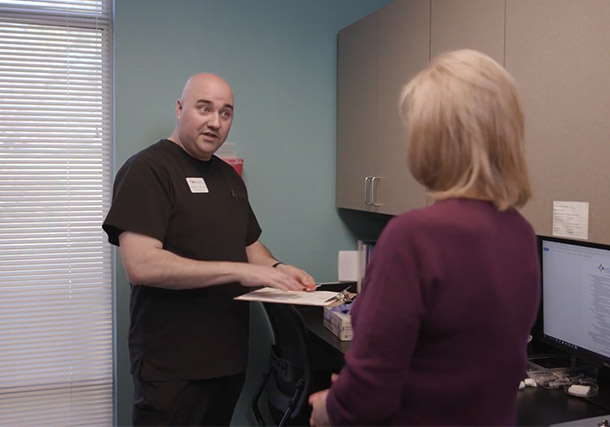
Anaphylaxis Treatment in Charlotte
If you’re seeking information about and treatment for anaphylaxis as an allergic reaction, Carolina Asthma and Allergy Center can provide the answers you’ve been looking for. We specialize in comprehensive evaluation and treatment for allergies, including the prevention and management of anaphylaxis.
Most have heard of allergic reactions, but few understand the characteristics of the most serious and life-threatening allergic reaction known as anaphylaxis. According to the Asthma and Allergy Foundation of America (AAFA), anaphylaxis is a common occurrence in the United States. This life-threatening allergic reaction was found to be present in about one of every 50 people. However, many experts think this number could actually be even higher with closer to one in 20 people suffering from the condition.
If you’re interested in exploring how we can help educate and assist you with anaphylaxis treatment, we encourage you to consult with our experienced allergists. Our dedicated team will assess your allergies, evaluate your symptoms, and provide thorough management plans for your allergies.
Contact us today to schedule a consultation and discover the different ways you can effectively manage your allergies. Our team is here to guide you toward a healthier and more comfortable future.
How to Request an Appointment
Booking an appointment is hassle-free. You can simply reach out to our office by phone or complete the online appointment request form on our website. Our friendly and accommodating staff will collaborate with you to find a date and time that suits your schedule perfectly.
During your scheduled appointment, our skilled allergists will conduct a comprehensive evaluation of your medical history and perform a thorough physical examination. To accurately diagnose the presence of any allergies, we will customize a range of tests to address your specific needs.
Based on the results of your evaluation and tests, our experienced team will create a personalized treatment plan designed to effectively manage your allergy symptoms and prevent future allergic reactions. As part of this plan, our experts may discuss how you can prevent and treat anaphylaxis in the future.
Take the important step toward understanding and effectively managing your allergies by contacting us today to request an appointment. Our dedicated team is committed to supporting you on your journey to a more convenient lifestyle.
What is Anaphylaxis?
Anaphylaxis is a severe and potentially life-threatening allergic reaction that is both quick and severe. It can occur within just minutes, or even seconds, after you’ve been exposed to the substance that you’re allergic to like a bee sting, latex, or peanuts.
During anaphylaxis, your body’s immune system goes into overdrive, releasing a wave of chemicals that could cause you to go into shock. During this time, your blood pressure decreases, your pulse weakens, and your airways narrow so your breathing becomes blocked. Nausea, vomiting, and skin rash can also occur.

What Causes Anaphylaxis?
Anaphylaxis, as well as allergies in general, occurs when the body overreacts to an allergen.
When the body is exposed to an allergen, it responds by producing histamine and other chemicals causing your blood vessels to dilate. This allows more fluid to enter your tissues and causes swelling. During anaphylaxis, these chemicals are released throughout the whole body and can cause low blood pressure, hives, and difficulty breathing.
This reaction occurs as a result of your immune system, which is designed to protect you when you are exposed to foreign substances. Your body produces antibodies that are recognized the next time you are exposed to that trigger.
That is why anaphylactic shock doesn’t always happen the first time you are exposed to an allergen, but may occur the next time you come in contact with the allergen.
Common Causes of Anaphylaxis
Food allergies are the most common cause of anaphylaxis. Some prevalent triggers include:
- shellfish
- nuts
- milk
- eggs
- fish
- some fruits
Insect stings, especially those from bees or wasps, can also trigger anaphylaxis. Medicines, like non-steroidal anti-inflammatory drugs (NSAIDs) like aspirin, as well as some antibiotics, can result in anaphylaxis.
General anesthetic, contrast agents (the dyes that are used in certain medical tests to make areas of your body more visible on scans), and latex (a kind of rubber that can be found in condoms and some rubber gloves) are other common causes of anaphylaxis.
There are also some less commonly seen causes of anaphylaxis that could occur including a delayed reaction to eating red meat, an allergen that is in sesame seeds called oleosins, flour that has been contaminated by mites, and lupin from seeds that were milled into flour before being used in baked goods. Cold temperatures and exercise may also trigger anaphylaxis in certain individuals.
Idiopathic Anaphylaxis
Idiopathic anaphylaxis is the name given by the medical field when the cause for the allergic reaction isn’t known. Regardless, the symptoms are often the same and signal a medical emergency.
During idiopathic anaphylaxis, you could experience wheezing or other breathing problems, your airway could be partially blocked because your tongue is swollen, and you could have problems swallowing. You might have a rash or hives and you could even experience dizziness or pass out.
Though it is not clearly understood, there is a significant number of people who have idiopathic anaphylaxis whose condition gradually improves. Even if you have severe symptoms that are life-threatening, you might notice that you have fewer reactions over time.
It might surprise you to learn that anaphylactic reactions can vary widely from one person to another. You might even experience different variations in regards to the severity of your reactions, and the reactions themselves.
While your symptoms might worsen quickly at first, they might stay at the same severity level for quite some time before going away by themselves. Your symptoms could occur one after the other, alone, or all at the same time. Even if they have been treated, the symptoms could reappear once again in 24 hours.
Signs & Symptoms of Anaphylaxis
At first, it might not be obvious to you, and those around you, that you are having an anaphylactic reaction. Typically, the first signs — a skin rash or runny nose, for example — mimic those of an allergic reaction. Within about 30 minutes, however, you might see at least two of the following symptoms appear:
- swollen or itchy tongue and/or lips
- paleness
- rash, hives, itchy, red or swollen skin
- weak pulse
- confusion, dizziness, fainting or weakness
- cramps, diarrhea or vomiting
- sneezing, runny or stuffy nose
- chest tightness
- rapid heartbeat
- itching
- hoarse voice, trouble swallowing, throat tightness
- wheezing, pain, coughing
- itchy or swollen throat
There are four grades that can be used to categorize the severity of your reaction with Grade 1 being the least severe and Grade 4 being the most serious.
- Grade 1 symptoms typically involve the skin and can include skin rash, itching, swelling of the skin, and hives.
- Grade 2 symptoms include the signs from Grade 1 and also involve other systems. For example, you might experience a runny nose, hoarseness, and difficulty breathing. You could have cramping and vomiting, as well as low blood pressure, fast pulse, and an irregular heartbeat.
- Grade 3 symptoms include diarrhea, bloating, and the urge to have a bowel movement. Your skin and mucous membranes might take on a bluish tinge and you could have breathing difficulties. Because your body is not able to get enough blood to your organs, you could go into shock and lose consciousness.
- Grade 4 symptoms can include all of those mentioned above as well as respiratory arrest in which you stop breathing. You could also experience circulatory arrest during which the blood stops circulating throughout your body.
Anaphylactic reactions can often be mild, but even those have the potential to become life-threatening at any time. In most cases, this condition occurs quickly with symptoms reaching their peak within 5 to 30 minutes. Though it is rare, in some cases, your symptoms could linger for several days.
How to Treat Anaphylaxis
There are a number of anaphylaxis treatments that can help make you more comfortable. However, epinephrine is a prescription medication that is the only way that severe anaphylactic symptoms can be reversed.
In most cases, the effects of epinephrine stop about 15 to 20 minutes after it is used. If the response to the first dose is not adequate, a second dose could be required. A second dose of epinephrine might also be needed if the symptoms worsen within 15 minutes of the medication being administered.
Even if you respond well to epinephrine, you should still go to the nearest hospital emergency department after experiencing anaphylaxis. About 20 percent of anaphylaxis cases can experience late phase anaphylaxis which could be more difficult to treat.
Antihistamines, such as diphenhydramine (perhaps better known by its brand name of Benadryl) can be used after epinephrine has been administered. Though antihistamines can relieve the itching, swelling, and rash that is often associated with anaphylaxis, it cannot treat respiratory distress or cardiovascular symptoms. In addition, Benadryl works too slowly in order to be effective during a life-threatening emergency such as anaphylaxis.
When you are experiencing an anaphylactic incident, it’s likely that you’ll receive other treatment along with epinephrine. Cardiopulmonary resuscitation (CPR) might be administered if your heart stops beating or you aren’t breathing. You might also receive oxygen to help you breathe more easily as well as intravenous (IV) medications like cortisone and antihistamines that reduce inflammation. Albuterol, a beta-agonist that helps relieve the symptoms that lead to difficulty breathing, might also be administered.
Anaphylaxis is a serious medical emergency that requires immediate medical treatment in order for you to survive. Left untreated or under-treated, anaphylaxis could lead to death. Even if your symptoms go away fairly quickly, they can reappear a few hours later and be more serious and difficult to treat. This is why it’s critical that you seek emergency treatment any time you have an anaphylactic reaction.
What Should You Do if Someone Is Having an Allergic Reaction With Signs of Anaphylaxis?
If you are with someone and they seem to be having an allergic reaction with signs of anaphylaxis, swift action is required in order to protect their health. After first calling 911 or the local phone number for emergency services, ask if the person has an auto injector for epinephrine, or EpiPen, and if they need help administering it. If so, it is usually injected in their thigh.
Loosen any tight clothing the person has on and cover them with a blanket. Keep them as still as possible and lying on their back, but don’t allow them to have anything to eat or drink. If you see signs of bleeding from the person’s mouth or if they are vomiting, turn them onto their side so they don’t choke.
For people who are not moving, breathing, or coughing, you might need to give CPR. Aim to apply about 100 chest presses per minute uninterrupted until medical help arrives.
Even if the person’s symptoms start to get better, emergency treatment is still required. There is a significant subset of people who will experience a recurrence of symptoms within a few hours so professional monitoring is often required.
For people who have anaphylaxis but don’t have an epinephrine auto injector, emergency medical treatment could save their life. You can try to give them antihistamines but be prepared for the medication to provide only minimal relief — if any at all.
How Can You Prevent Anaphylaxis?
Anaphylaxis is best prevented by avoiding the foods, substances, or materials that trigger this severe allergic reaction. There are other practices of preparation that can prevent anaphylaxis:
- Wear a medical alert bracelet or necklace that details the substance or drugs you are allergic to
- Stock an emergency kit that contains all your prescribed medications including an epinephrine auto-injector, taking care to check its expiration date and have the auto-injector refilled before it expires
- Keep this emergency kit with you at all times and inform others about it so they can assist you with it if it’s needed
- Be cautious around areas where stinging insects are likely to be, if they are your trigger
- Stay vigilant when you’re eating out or have not personally prepared food that may have traces of your allergens in it
In addition, you should alert all of your medical professionals about your triggers and any reactions to medications you’ve experienced.
Summary
Carolina Asthma & Allergy Center is the area’s largest asthma and allergy practice that’s made up entirely of board-certified physicians, certified in Allergy & Immunology. If you would like to learn more about how to manage your allergy symptoms and prevent anaphylaxis, please make an appointment with one of our board-certified allergists. This is your first step to leading a full life without worrying about your allergies!
Anaphylaxis FAQs
How is anaphylaxis diagnosed?
Your doctor will know that you have anaphylaxis because of the symptoms that you display or tell them about. During your appointment, you’ll likely be asked if you have been exposed recently to any of the common triggers. Though it can be difficult to know if you will have a severe allergic reaction before it occurs, if you have a history of such issues, it is likely that you’ll have a severe one in the future.



